
Euphorbia esula, commonly known as green spurge or leafy spurge, is a species of spurge native to central and southern Europe, and eastward through most of Asia north of the Himalaya to Korea and eastern Siberia.

The blue spruce, also commonly known as green spruce, white spruce, Colorado spruce, or Colorado blue spruce, is a species of spruce tree. It is native to North America, and is found in USDA growing zones 1 through 7. It is found naturally in Arizona, Colorado, Idaho, New Mexico, Utah and Wyoming. It has been widely introduced elsewhere and is used as an ornamental tree in many places far beyond its native range. The blue spruce has blue-green colored needles and is a coniferous tree.

Lepidium virginicum, also known as least pepperwort or Virginia pepperweed, is an herbaceous plant in the mustard family (Brassicaceae). It is native to much of North America, including most of the United States and Mexico and southern regions of Canada, as well as most of Central America. It can be found elsewhere as an introduced species.

Stephanomeria is a genus of North American plants also known as wirelettuce, belonging to the tribe Cichorieae within the family Asteraceae.
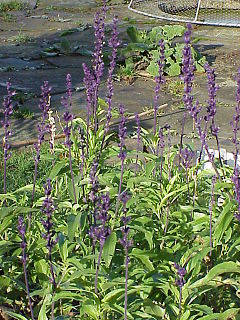
Salvia farinacea, the mealycup sage, or mealy sage, is a herbaceous perennial native to Nuevo León, Mexico and parts of the United States including Texas and Oklahoma. Violet-blue spikes rest on a compact plant of typically narrow salvia-like leaves; however, the shiny leaves are what set this species apart from most other Salvia, which bear velvety-dull leaves.
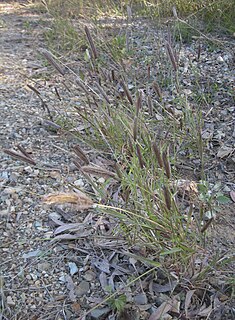
Chloris virgata is a species of grass known by the common names feather fingergrassfeathery Rhodes-grass and feather windmillgrass.
Lessingia virgata is a species of flowering plant in the family Asteraceae known by the common name wand lessingia. It is endemic to California, where it is known from the eastern side of the Central Valley and adjacent Sierra Nevada foothills. It is a woolly, glandular annual herb growing up to about 60 centimeters tall with slender, spreading branches. The upper leaves are no more than a centimeter long, while the lower ones are longer and sometimes divided into lobes or teeth. The flower heads appear singly in leaf axils, each lined with purple-tipped, glandular, woolly phyllaries. The head is discoid, containing no ray florets but a few tubular light lavender to nearly white disc florets with long, narrow lobes. The fruit is an achene with a whitish pappus on top.
Munzothamnus is a monotypic genus of flowering plants in the family Asteraceae containing the single species Munzothamnus blairii, which is known by the common name Blair's wirelettuce, or Blair's munzothamnus. It is endemic to San Clemente Island, one of the Channel Islands of California. It grows along steep, rocky cliffsides and canyons on the island. It is a shrub producing a fleshy, woolly stem usually over a meter in height, often approaching two meters. Leaves occur in tufts at the ends of the stem branches. They are up to 15 centimeters long, oblong in shape, and sometimes very shallowly lobed. They are woolly when new but lose their hairs and become shiny green with age. The inflorescence is a large array of up to 35 flower heads. Each head has a cylindrical base under a centimetre long and contains 9 to 12 light lavender or pinkish flowers. Each flower is a ray floret with an erect tube and a strap-shaped ligule with a toothed tip. The ligule is just under a centimetre long. The fruit is a cylindrical, ribbed achene with a white pappus.
Prenanthella is a monotypic genus of flowering plants in the family Asteraceae. It contains the single species Prenanthella exigua, which is known by the common name brightwhite. It is native to the southwestern United States from California to Texas and it is known as far north as Idaho. Its habitat includes desert and woodlands. This annual herb produces a slender, branching stem reaching a maximum height near 40 centimeters. It has a sparse coating of glandular hairs and contains a milky juice. Most of the leaves are located near the base of the stem. They are widely lance-shaped and sometimes divided into segments. Smaller leaves occur higher on the stem; these may be reduced to scale-like structures, leaving the stem mostly bare. The inflorescence is a wide open panicle of several flower heads. Each small head is cylindrical and narrow, its base wrapped in lance-shaped phyllaries. At the tip of the head bloom 3 or 4 flowers, which are ray florets; there are no disc florets. Each floret has is white to pale pink and has a toothed tip. The fruit is a white achene with a pappus of white bristles.

Stephanomeria malheurensis, the Malheur wirelettuce, is a species of flowering plant in the family Asteraceae. It is endemic to Oregon in the United States. It is a federally listed endangered species.

Stephanomeria exigua, the small wirelettuce, is a perennial or biennial plant native to the western United States. It is thought to be the parent species of Stephanomeria malheurensis, an endangered plant species found only in southern Oregon. It generally blooms from mid-spring to late summer and produces small, light pink or light purple blooms.
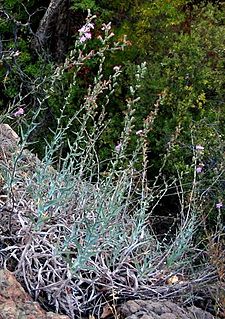
Stephanomeria cichoriacea is a species of flowering plant in the family Asteraceae; it is known by the common names chicoryleaf wirelettuce and silver rock-lettuce. It is endemic to California, where it grows in the coastal mountain ranges as far north as Monterey County, but especially in southern California mountains such as the Transverse Ranges. Its habitat includes chaparral. It is a perennial herb producing slender erect stems reaching maximum heights exceeding one meter. The stem is woolly with hairs, especially on new growth. The leaves are mostly located in a basal rosette, the largest reaching 18 to 20 centimeters long. They are lance-shaped and often toothed along the edges, and the newer ones are woolly. Smaller leaves occur farther up the stem. The inflorescence is a long array of several flower heads, with some occurring in the upper leaf axils as well. Each head has a cylindrical base 1 to 2 centimeters long which is lined with layers of glandular phyllaries. The head contains 10 to 15 ray florets, each with an elongated tube and a pink ligule which may be up to 2 centimeters long. The fruit is an achene tipped with a spreading cluster of long, plumelike pappus bristles.
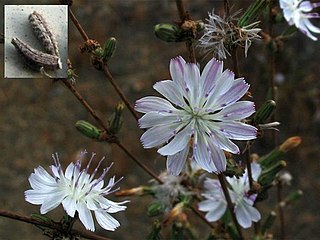
Stephanomeria diegensis is a species of flowering plant in the family Asteraceae known by the common name San Diego wirelettuce. It is native to the coastal hills and ranges of southern California and Baja California, where it grows in many types of open habitat. It evolved as a hybrid of Stephanomeria exigua and S. virgata. Furthermore, it is thought to be the result of homoploid hybrid speciation, which is uncommon. The plant is frequently misidentified as one of its parents, especially if older taxonomic keys are used. This is an erect annual herb easily exceeding two meters in height. Its slender stem has many spreading branches. The basal leaves are linear to lance-shaped and up to 10 centimeters long. The leaves wither early and are absent for most of the year, giving the plant a twiglike appearance. Leaves on the upper stem are small and reduced. The inflorescences are usually clusters of flower heads located at intervals on the stiff branches. Each head has a cylindrical base lined with phyllaries. These are often glandular. The head contains several ray florets, each with an elongated tube and a white or pink-tinged ligule measuring around a centimeter long. The fruit is a grooved achene tipped with a spreading cluster of long, plumelike pappus bristles.
Stephanomeria elata is a species of flowering plant in the family Asteraceae known by the common names Santa Barbara wirelettuce and Nuttall's wirelettuce. It is native to Oregon and California, where it grows in coastal and inland mountain ranges, including the Sierra Nevada. It can be found in many types of habitat. It is an annual herb producing a slender, erect stem often exceeding one meter in maximum height. It is hairy to hairless and often glandular. The leaves are mostly located in a basal rosette, the largest reaching 10 centimeters long. Smaller, much-reduced leaves occur farther up the stem. The leaves drop early, leaving the plant naked for most of the year. Flowers occur singly or in small clusters along the stiff branches. Each head contains up to 15 or 16 ray florets, each with an elongated tube and a pink ligule 6 or 7 millimeters long. The fruit is an achene tipped with a spreading cluster of long, plumelike pappus bristles.

Stephanomeria lactucina is a species of flowering plant in the family Asteraceae known by the common names lettuce wirelettuce and woodland wirelettuce. It is native to Oregon and California, where it grows in coastal and inland mountain ranges, including the Sierra Nevada. It can be found in many types of habitat, including coniferous forests. It is rhizomatous perennial herb producing a slender, erect stem reaching 30 to 60 centimeters in maximum height. The linear or lance-shaped leaves are up to 8 centimeters long and their edges are lined with widely spaced teeth. Solitary flower heads occur on erect peduncles. Each head contains up to 10 ray florets, each with an elongated tube and a fringed pink ligule roughly a centimeter long. The fruit is an achene tipped with a spreading cluster of long, plumelike pappus bristles.
Stephanomeria paniculata is a species of flowering plant in the family Asteraceae known by the common names tufted wirelettuce and stiff-branched wirelettuce. It is native to the northwestern United States, where it grows in many types of habitat, including disturbed areas. It is an annual or biennial herb producing a slender, erect stem with stiff, widely spreading branches toward the top. It is hairless. The leaves are mostly located in a basal rosette, the largest reaching 10 centimeters long. Smaller, linear leaves occur along the upper stem. Flower heads occur singly or in small clusters along the stiff branches. Each head contains 4 to 6 ray florets, each with an elongated tube and a pinkish or lavender ligule up to 1.4 centimeters long. The fruit is an achene tipped with a spreading cluster of long, white pappus bristles.
Stephanomeria parryi is a species of flowering plant in the family Asteraceae known by the common name Parry's wirelettuce. It is native to the southwestern United States, where it grows in many types of habitat, including many desert areas. It is a perennial herb growing from a thick root and producing one or more slender, upright stems up to about 40 centimeters tall. The green leaves are linear to lance-shaped with lobed edges and are up to 8 centimeters long near the base of the plant. Flower heads occur on the spreading branches. Each has up to 13 or 14 ray florets, each with an elongated tube and a whitish ligule up to 1.5 centimeters long. The fruit is an achene tipped with a spreading cluster of long, tan, plumelike pappus bristles.

Stephanomeria pauciflora is a species of flowering plant in the aster family known by the common names brownplume wirelettuce, few-flowered wirelettuce, and prairie skeletonplant. It is native to the southwestern United States and northern Mexico, where it grows in many types of habitat, including many desert areas, woodlands, and plains. It is a perennial herb or bushy subshrub producing one or more sturdy, stiff stems with many spreading branches, taking a rounded but vertical form. The leaves are mostly basal and ephemeral, with smaller, scale-like leaves occurring on the upper stem. Flower heads occur at intervals along the mostly naked stems, especially near the tips. Each has a cylindrical base covered in hairless phyllaries. It contains 3 to 6 florets, each with an elongated tube and a flat pink ligule. The fruit is an achene tipped with a spreading cluster of plumelike pappus bristles. These are usually brownish, but are sometimes white. The specific epithet pauciflora, refers to the Latin term for 'few flowered'.
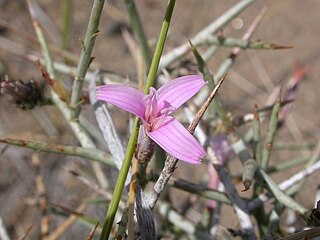
Pleiacanthus is a monotypic genus of flowering plants in the family Asteraceae containing the single species Pleiacanthus spinosus, which is known by the common name thorn skeletonweed, or thorny skeletonweed. It is native to the western United States from Montana and Idaho to southern California and Arizona, where it grows in many types of mostly dry habitat from deserts to mountains. It is a spindly subshrub producing several slender stems up to 40 or 50 centimeters tall from a woody caudex. The stems divide many times into short, rigid branches which narrow to sharp thorn-tips. The plant is mostly hairless except for brownish woolly tufts at the base and below the basal leaves. The leaves are small and linear on the lower stem, and reduced to scale-like growths on the upper branches. Flower heads occur near the ends of the branches. Each has a cylindrical base wrapped in one layer of phyllaries. The head contains 3 to 5 ray florets, each with an elongated tube and a pale to bright pink ligule. The fruit is an achene tipped with a cluster of pappus bristles which are not plumelike as are those of the Stephanomeria species with which this plant was once classified.

Stephanomeria tenuifolia, the narrow-leaved wire-lettuce or narrow leaved stephanomeria, is a perennial plant in the family Asteraceae that grows in the Great Basin of the western United States. It has five ray flowers that give it the appearance of being petals of a single flower of a plant in another plant family.














